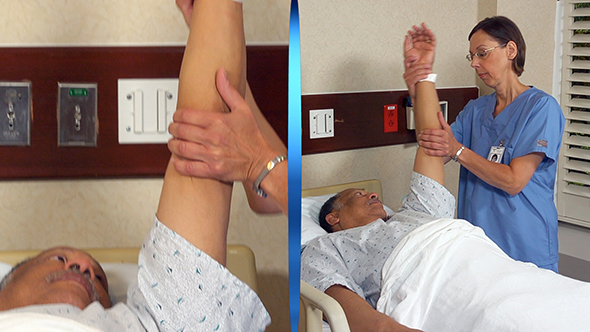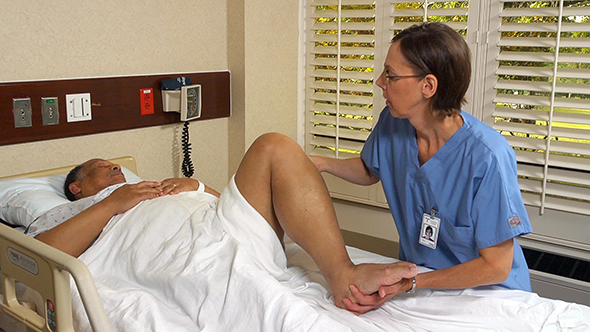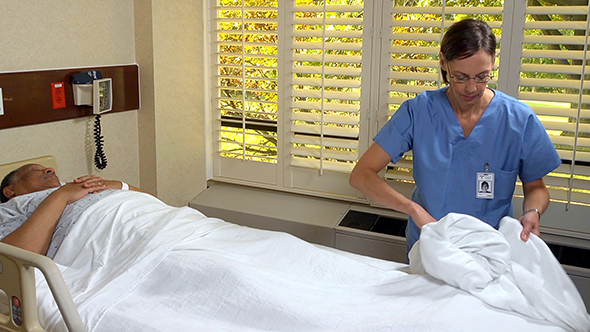Body Mechanics and Exercise
Select a Skill:
- » Moving the Person Up in Bed
- » Positioning the Person in Bed
- » Transferring the Person to a Chair or Wheelchair
- » Moving the Person to a Stretcher
- » Transferring the Person Using a Mechanical Lift
- » Assisting with Range-of-Motion Exercises
- » Helping the Person Walk
Take the Review Test:

Purpose

- Exercise helps prevent contractures, muscle atrophy, and other complications from bedrest. Some exercise occurs with activities of daily living and when turning and moving in bed without help. Other exercises are needed for muscles and joints.
- Joint range of motion (ROM) is the movement of a joint to the extent possible without causing pain. ROM exercises involve moving the joints through their complete range of motion. They are usually done at least two times a day.
- Active ROM exercises—The person does these exercises.
- Passive ROM exercises—You move joints through their range of motion.
- Active-assistive ROM exercises—The person does the exercises with some help.
- Joint movements include:
- Abduction—moving a body part away from the midline of the body
- Adduction—moving a body part toward the midline of the body
- Flexion—bending a body part
- Extension—straightening a body part
- Hyperextension—excessive straightening of a body part
- Dorsiflexion—bending the toes and foot up at the ankle
- Plantar flexion—bending the foot down at the ankle
- Rotation—turning the joint
- Internal rotation—turning the joint inward
- External rotation—turning the joint outward
- Pronation—turning the joint downward
- Supination—turning the joint upward.
Equipment
Roll cursor over items to see labels. For the purposes of clearly depicting the equipment, a barrier is not shown in this photo. When providing care, a barrier should always be placed on the surface before placing the equipment.

Bath blanket
Delegation
Follow delegation guidelines. Before assisting with ROM exercises, obtain this information from the nurse and care plan:
- The ROM exercises ordered—active, passive, or active-assistive
- Which joints to exercise
- How often the exercises are done
- How many times to repeat each exercise
- What observations to report and record
- When to report observations
- What patient or resident concerns to report at once
Preparation

- Observe quality-of-life measures.
- Review the information under Delegation and Safety and Comfort.
- Practice hand hygiene.
- Identify the person. Check the ID bracelet against the assignment sheet. Also call the person by name.
- Obtain a bath blanket.
- Provide for privacy.
- Raise the bed for body mechanics. Bed rails are up if used.
Safety

- Exercise only the joints the nurse tells you to exercise.
- Expose only the body parts being exercised.
- Use good body mechanics.
- Support the part being exercised.
- Move the joint slowly, smoothly, and gently.
- Do not force a joint beyond its present range of motion.
- Do not force a joint to the point of pain. Remind the person to tell you if he or she has pain during the procedure. ROM exercises can cause muscle and joint injury and pain if not done properly.
- Perform ROM exercises to the neck only if allowed by your agency and if the nurse instructs you to do so. In some agencies, only physical therapists do neck exercises.
Comfort
- Promote physical comfort during ROM exercises.
- Ask the person if he or she has pain or discomfort.
- Provide privacy to promote mental comfort. Cover the person with a bath blanket for warmth and privacy.
Procedure Video
Audio Description: OFFFollow-up Care

- Provide for comfort.
- Remove the bath blanket.
- Place the call light within reach.
- Lower the bed to its lowest level.
- Raise or lower bed rails. Follow the care plan.
- Fold and return the bath blanket to its proper place.
- Unscreen the person.
- Complete a safety check of the room.
- Practice hand hygiene.
Reporting/Recording
Report and record your observations, including:
- The time the exercises were performed
- The joints exercised
- The number of times the exercises were performed on each joint
- Complaints of pain or signs of stiffness or spasm
- The degree to which the person took part in the exercises
Review Questions
Select the best answer.
1. What is one of the purposes of range-of-motion (ROM) exercises?
Select the best answer.
2. When assisting with ROM exercises, which technique should you use?
 Support the joint being exercised.
Support the joint being exercised. Exercise each joint quickly.
Exercise each joint quickly. Move each joint past the point of resistance.
Move each joint past the point of resistance. Perform neck ROM exercises for all persons.
Perform neck ROM exercises for all persons.
Select the best answer.
3. Which action is appropriate when preparing to assist with ROM exercises?
 Ask which joints the person wants to exercise.
Ask which joints the person wants to exercise. Determine how frequently to do ROM exercises based on the person’s ability to tolerate them.
Determine how frequently to do ROM exercises based on the person’s ability to tolerate them. Remind the person to tell you if pain occurs during the procedure.
Remind the person to tell you if pain occurs during the procedure. Begin with the person standing comfortably at the side of the bed.
Begin with the person standing comfortably at the side of the bed.
Select the best answer.
4. Which type of ROM exercises does the person do with some help?
 Active ROM exercises
Active ROM exercises Passive ROM exercises
Passive ROM exercises Active-passive ROM exercises
Active-passive ROM exercises Active-assistive ROM exercises
Active-assistive ROM exercises
Select the best answer.
5. In which type of joint movement does the joint turn outward?
You have completed the Review Questions for this skill. To take the Review again select the Start Over button. To proceed to another skill select from the dropdown menu. Select the Home or Back button to proceed to the next section.

